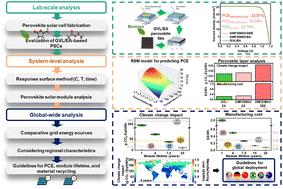推进钙钛矿太阳能电池与生物质衍生溶剂:可持续发展途径†
IF 9.2
1区 化学
Q1 CHEMISTRY, MULTIDISCIPLINARY
引用次数: 0
摘要
钙钛矿太阳能电池(PSCs)的传统制造依赖于对环境和健康有害的有毒溶剂,如N,N-二甲基甲酰胺和二甲基亚砜(DMF和DMSO)。本研究介绍了一种生物质衍生的绿色溶剂γ-戊内酯(GVL)作为钙钛矿前驱体加工的可持续替代品。通过将GVL与毒性较小的抗溶剂乙酸乙酯(EA)结合,PSCs的效率高达23.74%,不含有害化学物质。除了实验室规模的性能,我们还进行了系统级的评估,整合了技术经济分析和生命周期评估,以评估制造成本、环境影响和可扩展性。与DMF/DMSO系统相比,基于GVL/ ea的psc可以降低50%的制造成本,减少80%的气候变化影响。此外,考虑到组件寿命和回收策略,全球部署方案确定了盈亏平衡点,这些绿色psc可以有效地与包括硅光伏在内的其他可再生能源竞争。总的来说,我们的研究结果突出了GVL/EA溶剂系统的潜力,为商业化提供了更安全、更可持续、更经济可行的途径。本文章由计算机程序翻译,如有差异,请以英文原文为准。

Advancing perovskite solar cells with biomass-derived solvents: a pathway to sustainability†
The conventional fabrication of perovskite solar cells (PSCs) relies on toxic solvents such as N,N-dimethylformamide and dimethyl sulfoxide (DMF and DMSO), which are harmful to the environment and health. This study introduces γ-valerolactone (GVL), a biomass-derived green solvent, as a sustainable alternative for perovskite precursor processing. By combining GVL with ethyl acetate (EA), a less toxic antisolvent, PSCs achieve a high efficiency of 23.74% without hazardous chemicals. Beyond laboratory-scale performance, we conducted a system-level evaluation integrating techno-economic analysis and life-cycle assessment to assess the manufacturing cost, environmental impact, and scalability. GVL/EA-based PSCs can lower manufacturing costs by 50% and reduce climate change impact by 80% compared to DMF/DMSO systems. Furthermore, global deployment scenarios identify break-even points—considering module lifetime and recycling strategies—where these green PSCs can effectively compete with other renewable energy sources including silicon photovoltaics. Overall, our findings highlight the potential of the GVL/EA solvent system to enable a safer, more sustainable, and economically viable route for commercialization.
求助全文
通过发布文献求助,成功后即可免费获取论文全文。
去求助
来源期刊

Green Chemistry
化学-化学综合
CiteScore
16.10
自引率
7.10%
发文量
677
审稿时长
1.4 months
期刊介绍:
Green Chemistry is a journal that provides a unique forum for the publication of innovative research on the development of alternative green and sustainable technologies. The scope of Green Chemistry is based on the definition proposed by Anastas and Warner (Green Chemistry: Theory and Practice, P T Anastas and J C Warner, Oxford University Press, Oxford, 1998), which defines green chemistry as the utilisation of a set of principles that reduces or eliminates the use or generation of hazardous substances in the design, manufacture and application of chemical products. Green Chemistry aims to reduce the environmental impact of the chemical enterprise by developing a technology base that is inherently non-toxic to living things and the environment. The journal welcomes submissions on all aspects of research relating to this endeavor and publishes original and significant cutting-edge research that is likely to be of wide general appeal. For a work to be published, it must present a significant advance in green chemistry, including a comparison with existing methods and a demonstration of advantages over those methods.
 求助内容:
求助内容: 应助结果提醒方式:
应助结果提醒方式:


